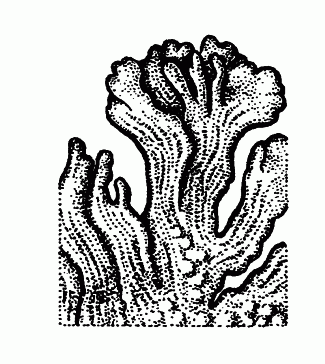Click on the image below to view an
expanded illustration for this species.

|
General:
Common Name: The Brownette Lichens. Stresses the miniature size and superficial resemblance to certain species of “brown” lichens (e.g., Melanelia and Neofuscelia).
Minute to small stratified to nonstratified foliose or occasionally squamulose lichens, corticate above and below, isidiate or not, lobes closely appressed or partly semi-erect, elongate-linear, linear or occasionally short, averaging to (0.1–) 0.2–0.8 (–l.5) mm wide, thin. Upper surface dark olive-brown or blackish, smooth or longitudinally striate. Lower surface dark or occasionally pale, bearing blue-green or occasionally pale rhizines, these often extending outward from thallus as prothallus. Medulla white. Photobiont blue-green.
Apothecia located over upper surface, disc dark brown to black; spores 2- to 4-celled, ellipsoid to somewhat spindle-shaped/fusiform, colourless, (4-) 8 per ascus.
Over rock, rarely over bark.
Notes: Placynthium is primarily a temperate genus, consisting of approximately 25 species worldwide. Of the six species occurring in North America, five are reported from B.C. In this taxonomically rather difficult genus, conclusive identification of some species requires detailed anatomical studies (see Henssen 1963d). No lichen substances have been reported.
Species description:
Thallus broadly or narrowly attached to substrate, but not umbilicateAND
Thallus brownish; lobes not at all swollen; substrate variousAND
Lobes either mostly appressed to substate or, if erect, then over rock AND
Lower surface and rhizines blue-green or blackish AND
Peripheral lobes essentially continuous with thallus, elongate or short, but never scalelike; hypothallus inconspicuous or absent AND
Over acid rock; lobes occasionally averaging to more than 0.2 mm wide; thallus never forming concentric rings AND
Peripheral lobes averaging to less than 0.2 mm wide, often shiny and either convex or weakly channelled; “isidia,” if present, more or less erect, granular to more often elongate-cylindrical
OR
Thallus broadly or narrowly attached to substrate, but not umbilicate AND
Thallus brownish; lobes not at all swollen; substrate various AND
Lobes either mostly appressed to substate or, if erect, then over rock AND
Lower surface and rhizines blue-green or blackish AND
Peripheral lobes essentially continuous with thallus, elongate or short, but never scalelike; hypothallus inconspicuous or absent AND
Over base-rich rock; lobes averaging to 0.2 mm wide or less; thallus sometimes forming concentric rings AND
Upper surface of peripheral lobes concave and distinctly longitudinally grooved; lobe tips separate to rarely crowded; thallus usually not ring-forming
Source: Lichens of British Columbia |

